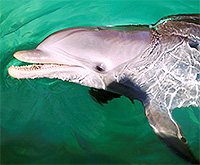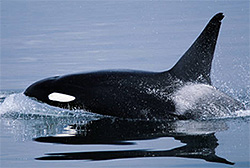Neuroscience For Kids
Navy Sonar versus Marine Mammals
By Norene Griffin, Neuroscience for Kids Guest Writer
September 23, 2013
 In the landscape under the ocean's surface, where light is
scarce and sound travels four times faster than in air, many marine mammals use
sound to communicate, navigate, and find food. Toothed
whales make noises and listen to how the noises bounce back to them to
determine the position and size of underwater objects. This process is
called echolocation.
Navies around the world use sound in similar ways, relying on active sonar
to locate targets.
In the landscape under the ocean's surface, where light is
scarce and sound travels four times faster than in air, many marine mammals use
sound to communicate, navigate, and find food. Toothed
whales make noises and listen to how the noises bounce back to them to
determine the position and size of underwater objects. This process is
called echolocation.
Navies around the world use sound in similar ways, relying on active sonar
to locate targets.
Marine biologists are sounding the alarm that the increased use of underwater sonar over the past 50 years may be harming some toothed whale populations. Military sonar can be four times as loud as a whale call. Scientists have found convincing evidence that military sonar can interfere with the hearing, communication, and behavioral patterns of dolphins and whales. This can result in stress, injury, or even death. When and where the U.S. Navy can use sonar is an ongoing controversy. The California Coastal Commission is tasked with protecting California's ocean and the animals that live in it. The U.S. Navy has rejected the Commission's recommendations for reducing or avoiding sonar use in sensitive conditions during testing and training exercises off the California coast.
 Navy spokesperson Alex Stone has said that at least one of
the Commission's recommendations-increasing the size of shutdown areas
when toothed whales are present-would negatively impact "training
realism." The Coastal Commission says its recommendations would bring the
Navy into compliance with the Coastal Act, which requires special
protection be given to "areas and species of biological and economic
significance."
Navy spokesperson Alex Stone has said that at least one of
the Commission's recommendations-increasing the size of shutdown areas
when toothed whales are present-would negatively impact "training
realism." The Coastal Commission says its recommendations would bring the
Navy into compliance with the Coastal Act, which requires special
protection be given to "areas and species of biological and economic
significance."
How Many Animals?
The Navy estimates that its planned activities could change the natural behavior patterns of as many as 1.78 million marine mammals each year, affecting migration, surfacing, nursing, breeding, feeding, or sheltering. Another 336 could sustain injuries each year such as temporary or permanent hearing loss or "bubble lesions" that cause symptoms similar to decompression sickness. As many as 26 animals may die.
Mass Strandings
Mass strandings are events in which groups of marine mammals beach themselves. Most beached dolphins and whales die. Navy sonar most likely is responsible for a number of mass strandings around the world. According to a 2004 International Whaling Commission report, tactical mid-frequency sonar was the probable cause of 10 mass strandings near Japan in an area used for U.S. Navy training. The exact cause for mass strandings remains unclear. Scientists have found that sonar may cause widespread hearing loss, which can affect marine mammals' ability to navigate.
 The U.S. Navy already has reduced mid-frequency sonar levels
since 2004, but those adjustments may not be enough. A study published in
2013 found that Cuvier's beaked whales off the California coast displayed
a strong avoidance response to recordings that sounded like mid-frequency
active sonar signals, even when the signals were at lower levels than
those the U.S. Navy is allowed to use now.
The U.S. Navy already has reduced mid-frequency sonar levels
since 2004, but those adjustments may not be enough. A study published in
2013 found that Cuvier's beaked whales off the California coast displayed
a strong avoidance response to recordings that sounded like mid-frequency
active sonar signals, even when the signals were at lower levels than
those the U.S. Navy is allowed to use now.
Recommendations and Protections
The Coastal Commission recommendations rejected by the Navy include:
- Establishing larger areas (up to 2 km/1.25 miles) where no sonar is allowed when marine mammals are nearby.
- Avoiding use of mid-frequency sonar in biologically sensitive areas like marine sanctuaries.
- Reducing sonar sound levels when marine mammals are difficult to spot due to darkness or low visibility.
The U.S. Navy doesn't have to follow the Commission's recommendations, but under the Marine Mammal Protection Act it does need a permit from the National Marine Fisheries Service for the "incidental" harassment or injury of dolphins and whales. The Navy's proposal for a 5-year marine permit renewal is currently under review. A decision is expected in November 2013.
Did you know?
- The brain of a bottlenose dolphin weighs 1.5 to 1.6 kg.
- The brain of a killer whale weighs about 5.62 kg.
- The brain of an adult human weighs about 1.4 kg.
- "Sonar" comes from the words SOund Navigation And Ranging.
References and further information:
- Author(s) unknown. (2004). International Whaling Commission, Scientific Committee (IWC-SC) Report, Annex K: Report of the Standing Working Group on Environmental Concerns. Submitted at the IWC56 meeting, July 2004. Retrieved from: http://www.acousticecology.org/docs/IWC56-noisesymposium.doc [Accessed: 13th Sep 2013]
- California Coastal Commission. (2013). Public Resources Code, Division 20, California Coastal Act. San Francisco, CA. Retrieved from: http://www.coastal.ca.gov/coastact.pdf [Accessed: 13th Sep 2013]
- California Coastal Commission. (2013). Staff Report, Consistency Determination No.: CD-008-13, Federal Agency: Department of the Navy. San Francisco, CA. Retrieved from: http://documents.coastal.ca.gov/reports/2013/3/F9a-3-2013.pdf [Accessed: 13th Sep 2013]
- National Oceanic and Atmospheric Association, (2013). Takes of Marine Mammals Incidental to Specified Activities; U.S. Navy Training and Testing Activities in the Hawaii-Southern California Training and Testing Study Area (Federal Register Document Number 2013-01808). Washington, DC Retrieved from: https://federalregister.gov/a/2013/01808 [Accessed: 13th Sep 2013]
- DeRuiter, S.L., Southall, B.L., Calambokidis, J., Zimmer W.M.X., Sadykova, D., Falcone, E.A., Friedlaender, A.S., Joseph, J.E., Moretti, D., Schorr, G.S., Thomas, L., & Tyack, P.L. First direct measurements of behavioural responses by Cuvier's beaked whales to mid-frequency active sonar. Biol. Lett., 2013, 9, 20130223, published 3 July 2013 doi: 10.1098/rsbl.2013.0223
- Mann, D., Hill-Cook, M., Manire, C., Greenhow, D., Montie, E., Powell, J., Wells, R., Bauer, G., Cunningham-Smith, P., Lingenfelser, R., DiGiovanni, R., Jr, Stone, A., Brodsky, M., Stevens. R., Kieffer, G., & Hoetjes, P. Hearing Loss in Stranded Odontocete Dolphins and Whales. PLoS ONE, 2010, 5(11): e13824. doi:10.1371/journal.pone.0013824
- Moore, J.E., & Barlow, J.P. Declining Abundance of Beaked Whales (Family Ziphiidae) in the California Current Large Marine Ecosystem. PLoS ONE, 2013, 8(1): e52770. doi:10.1371/journal.pone.0052770
- Parsons, E.C.M., Dolman, S.J., Wright, A.J., Rose, N.A., Burns, W.C.G., Navy sonar and cetaceans: Just how much does the gun need to smoke before we act? Marine Pollution Bulletin, Volume 56, Issue 7, July 2008, Pages 1248-1257 doi:10.1016/j.marpolbul.2008.04.025
- Carrington, D. (2013). Whales flee from military sonar leading to mass strandings, research shows. The Guardian, [online] 2nd July Retrieved from: http://www.theguardian.com/environment/2013/jul/03/whales-flee-military-sonar-strandings [Accessed: 13th Sep 2013]
- Sommer. L. (2013, April 26). Navy Sonar Criticized For Harming Marine Mammals. National Public Radio. Retrieved from http://www.npr.org/2013/04/26/179297747/navy-sonar-criticized-for-harming-marine-mammals [Accessed: 13th Sep 2013]
- Watters, J. (2013). Navy disputes finding on ocean sonar. San Diego Union-Tribune, [online] 20th August. Retrieved from: http://www.utsandiego.com/news/2013/Aug/20/navy-disputes-finding-on-ocean-sonar/ [Accessed: 13th Sep 2013
Norene Griffin is a freelance writer with a weakness for science news, art, and Pinterest. She lives in the San Francisco Bay Area with her husband and son.
Copyright © 1996-2013, Eric H. Chudler, University of Washington
